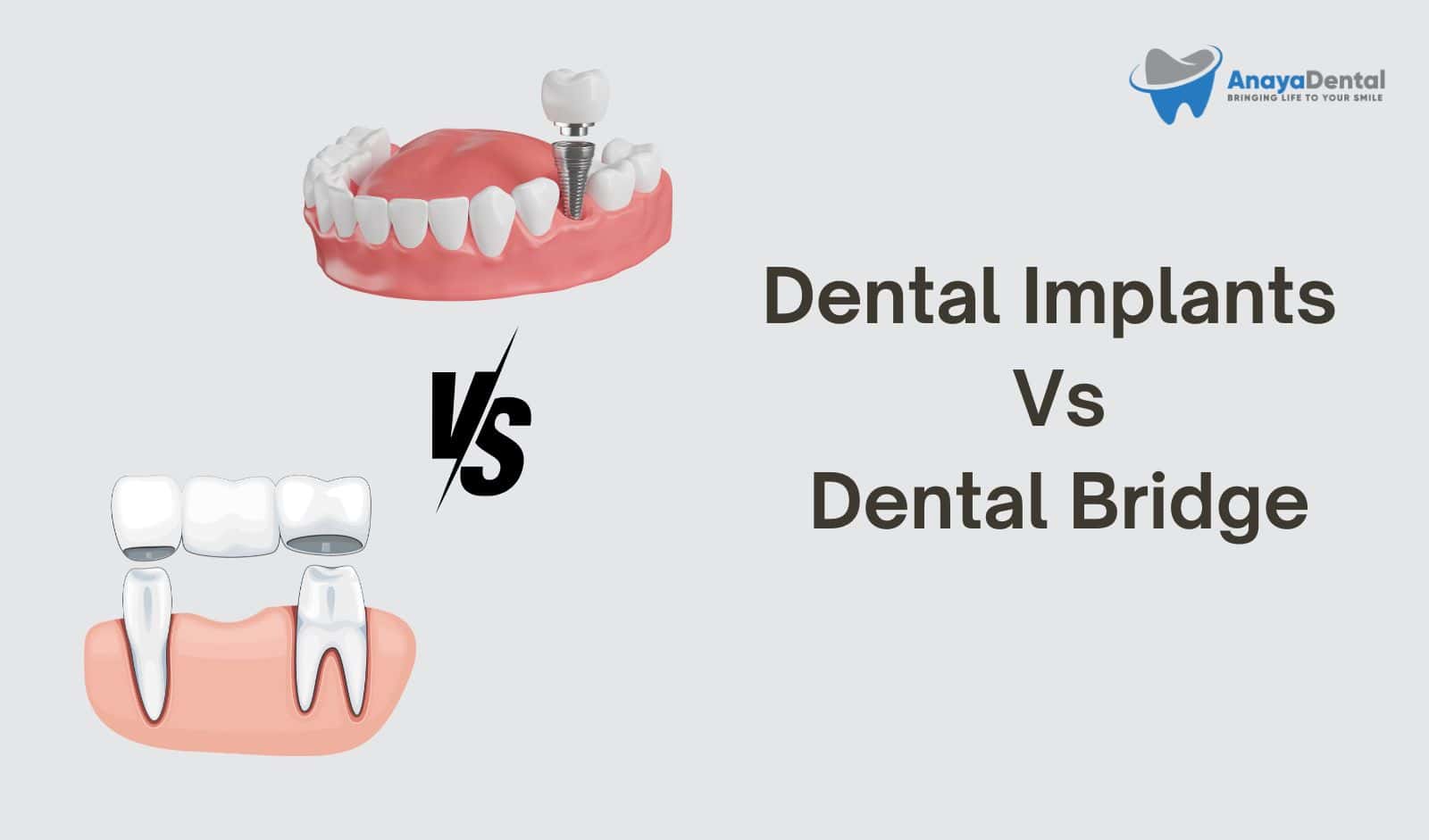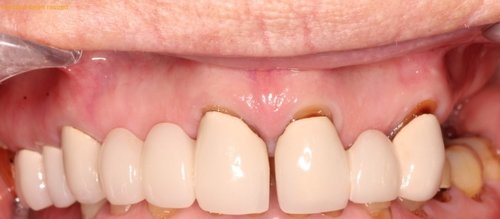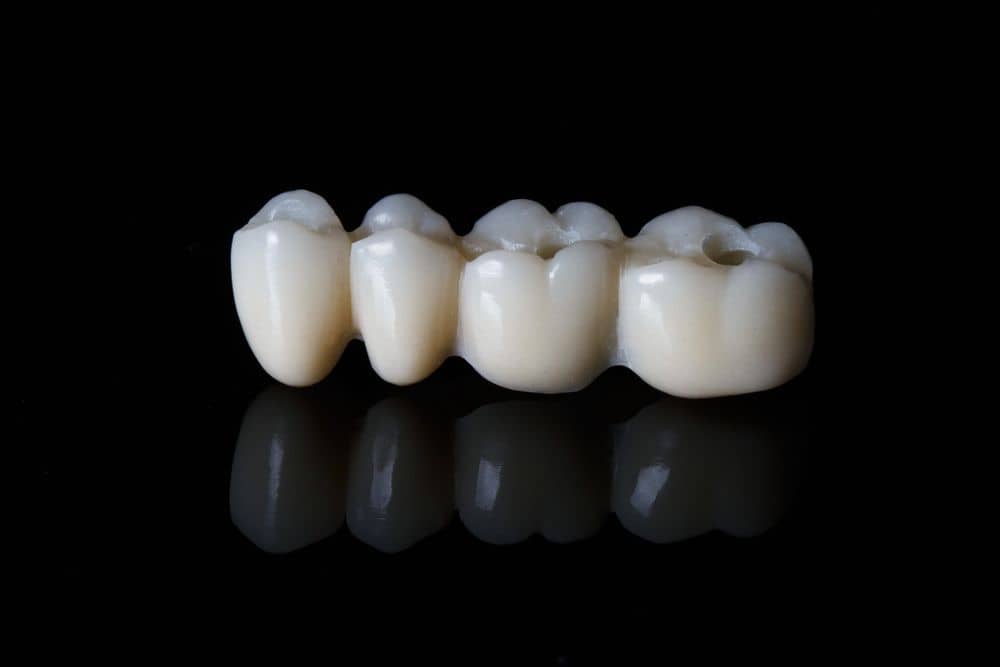Dental bridges are the most common, low risk and affordable option for the replacement of missing teeth. Dental bridge fills the gap created by the missing of one or more teeth and helps you restore your smile and chewing ability.
WHAT ARE DENTAL BRIDGES?
A dental bridge is a dental prosthesis that is definitively attached to the natural tooth and replaces the missing tooth with a material such as metal, porcelain, or a combination of materials such as metal and porcelain. Natural teeth are termed abutment teeth and the replaced tooth is termed pontic. Now, the question arises, what does a dental bridge look like?
- Temporary Dental Bridge- Why, Benefits, Pictures & Material
- Ill-Fitting Dental Bridge- Common Problems And Symptoms
- What To Do When My Dental Bridge Fell Out?
- Can A Dental Bridge Be Removed And Recemented?
- Replacing Front Teeth With A Bridge-Why, Pictures & Alternatives
- Tooth Decay Under Bridge- Causes, and Symptoms
- Temporary Dental bridge vs Permanent
- Temporary Dental Bridge Front Teeth
WHAT DOES A DENTAL BRIDGE LOOK LIKE?
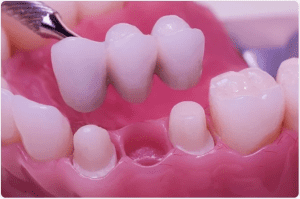
You may have heard of some famous bridges like the Golden Gate Bridge or Brooklyn bridge. Like the name suggests, a dental bridge is supported on either side and bridges the gap left by one or more missing teeth. However, if you have not seen a dental bridge, you may not be familiar with the structure of dental bridge and must be curious how a dental bridge looks, especially if you have to consider dental bridge as a treatment option. There are different types of dental bridge, they all have similar structures, but there is only a slight difference in appearance.
Try Our Dental Calculators
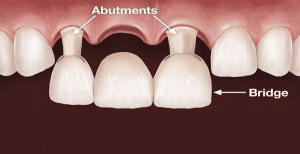
These differences are only noticeable before permanent cementation-
Conventional – Most commonly used type of bridge. This design takes support from adjacent teeth(abutments) on either side of the missing teeth. Abutments(natural teeth) on either side of the edentulous space should be able to support the bridge. Crowns, as well as pontics, are matched with the adjacent tooth color, contour, and texture. Once conventional bridges are placed in place in the mouth it is very difficult to distinguish them from natural teeth.
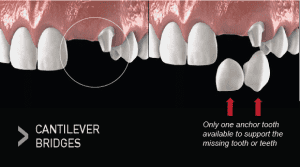
Cantilever – This type of bridge can be used when support can be obtained from a single side of missing teeth.

Resin-bonded or Maryland– Thin metal retainers are placed on the back surface of adjacent teeth like wings. The metal part is usually not visible. Retention is based on adhesive bonding between tooth and metal. A minimal amount of tooth alteration is required from the back surface of these teeth to form wings. It can not be used to replace posterior teeth because of more chewing forces.
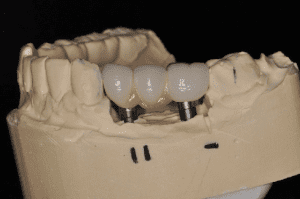
Implant-supported– If you do not want your natural teeth to get altered or trimmed then the best option is an implant-supported bridge. Implants are placed in the place of missing teeth and used to support the bridge. These are also used when adjacent teeth are missing more in number and not able to support the bridge. It will resemble the traditional dental bridge as implants are below the jaw line and act as natural teeth.
Although, there is a slight difference in each type even after having the same structure which changes its appearance. You can select the type of bridge according to the requirements with the help of your dentist
MATERIALS USED FOR BRIDGES
Gold and Metal alloys- A few years back gold was used as a decorative tooth material but because of the increase in cost and esthetic concerns of people it is not used widely. Both gold and metal once were very popular as they require less tooth cutting and are very strong. But, nowadays these materials are used only in posterior teeth.
Porcelain fused to metal(PFM)– It is the most commonly used material at present. It consists of a metal substructure and coating of tooth-colored material (porcelain). Tooth shade can also be adjusted according to your tooth shade. It has the benefit of the strength of metal as well as esthetics. But the main drawback with this material is that layering can be worn off and a grey tinge can appear after some time.
All-porcelain– This material has the most lifelike appearance. Strength is very less as compared to metal and requires more tooth cutting.
Zirconia– Most recent and advanced material used for bridges. Zirconia has strength almost equal to metal, tooth-colored, has a semi-translucent appearance. The main advantage of this material is that it requires minimal alteration.
WHO NEEDS THEM??
When one or two teeth are missing adjacent to healthy teeth on both sides. If missing teeth are not replaced on time, it can affect the function and esthetics. The teeth in the opposing jaw can move upward and teeth adjacent to edentulous space can migrate in the missing area.
DENTAL BRIDGE PROCEDURE STEP BY STEP
The process of making a dental bridge is simple and can be completed in a few appointments.
1. First of all, your dentist will anesthetize your abutment(adjacent to edentulous space) teeth using local anesthesia so that you will not suffer any pain or sensitivity.

2. Then, abutment teeth are ground using a bur and handpiece. Teeth are ground in such an amount so that the cap will not be bulky and give a natural appearance.
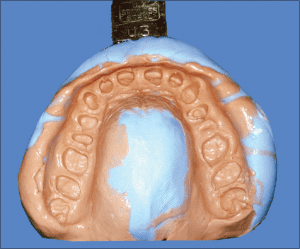
3. Then, the impression is made using various types of materials like alginate or silicone putty. The impression is then sent to the laboratory for fabrication of the bridge.
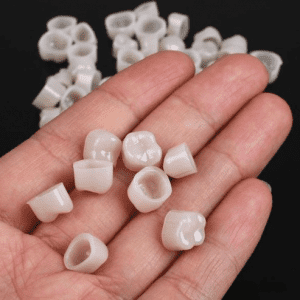
4. After that, your dentist will fabricate a temporary crown chairside so that you will not feel uncomfortable after the effect of local anesthesia subsides.
5. The framework then comes from the lab for testing the passive fit. Any adjustments can be done at this step by your dentist.
6. Finally, the finished bridge is to be placed in the patient’s mouth and final adjustments can be done. If everything is fine then the bridge can be placed with permanent cement.
DENTAL BRIDGE PROCEDURE PAIN
Dental Bridge procedure is not painful at all. If your teeth are not RCT treated, in that case your dentist will anaesthetized your teeth with local anesthesia before doing the tooth cutting.
Immediately, after cutting impressions are made and temporary restorations will be given to you by your dentist.
After wearing off the effect of local anesthesia, you feel slight pain or sensitivity to hot or cold but that will subside by itself or you can have over the counter pain medication to feel better.
But in case you feel severe pain you should contact your dentist immediately.
But, if your teeth to be used for bridge are RCT treated then you are not going to feel any pain and no need of even local anesthesia.
ADVANTAGES OF DENTAL BRIDGES
- Restoring the natural look and smile
- Restore proper speech
- Prevent drifting of adjacent and opposing teeth in missing area
- Maintain chewing capacity
- Bridges have the main benefit over denture that it doesn’t move as denture
DISADVANTAGES OF DENTAL BRIDGES
- Natural teeth need to be reduced to accommodate the bridge
- If the bridge is ill fitted, it will lead to caries in abutment
- Bridges can only be given if adjacent teeth have good support
BRIDGE OR IMPLANT
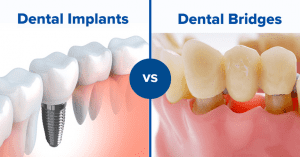
Dental implants are artificial tooth roots usually made from titanium. They’re placed into your jawbone with screws to hold a crown or bridge in place.
[wptb id=2184]
DOUBT- DENTAL BRIDGE OR IMPLANT?
It is important that you should know which option is better for you according to your health and expenses. Various factors affect the selection criteria such as-
Implant– Implant is more expensive than other treatment options but if your medical health is fine and you can afford implants then it is the best treatment option available.
General health– Implant success is dependent on your medical condition as well as oral condition. As in implants, metal inserts are placed in the jaw bone during surgery so, any condition like leukemia or blood disorder should not be there. Calcium or vitamin D should be in a proper ratio. Jawbone should also be able to properly support the implants.
The number of missing teeth– For a single missing tooth, the implant is the best option but as the number of missing teeth increases, cost increases, as well as complications, also increase.
Time– dental bridges require a maximum 1-2 weeks to be delivered but implants require a longer time. After the first surgery, implants are left to heal for 3- 6 months according to bone density. After that, a second surgery is done followed by crown delivery.
HOW LONG A DENTAL BRIDGE LASTS?
There are various opinions about the life of dental bridges but it depends on a person’s diet, lifestyle, and hygiene. The normal life of a dental bridge is 5- 7 years but if you maintain proper oral hygiene and diet it can last over 10 years.
ARE DENTAL BRIDGES PAINFUL?
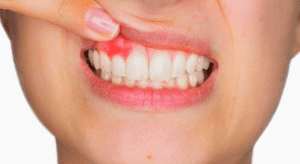
Dental bridges are not painful at all. A person may feel sensitivity during tooth cutting and may feel sensitivity until the final bridge is delivered. Also, a little discomfort is felt after bridge cementation for some days due to some new dental appliance in the mouth but slowly you will get accustomed. But, if discomfort persists or any pain under the bridge you should contact your dentist immediately.
DENTAL BRIDGE CLEANING TOOLS

After permanent cementation, you will get very easily used to it and feel natural. For long-lasting dental bridges, proper care is very important otherwise your abutment teeth will decay. Two times brushing and one time floss is a must under the dental bridge.
As the bridges are joined as one unit, cleaning in between them is not possible with dental floss. In that case, an interdental brush or waterpik can be used. You should learn the proper technique of brushing and flossing under the pontic from your dentist.



